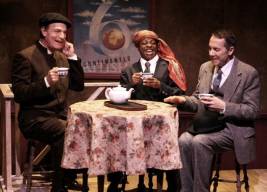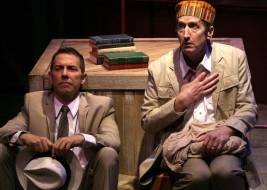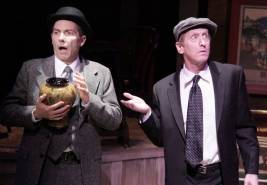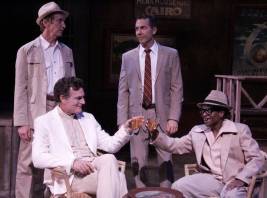
Imagine for a moment that Patrick Dennis had met his Auntie Mame when he was well into middle age rather than as a child. Imagine too that this meeting had occurred in the swinging ‘60s instead of the Roaring ‘20s, and that aunt and nephew had been British and not American. Imagine all this and what you’d come up with would be Graham Greene’s Travels With My Aunt, the famed author’s 1969 novel which playwright Giles Havergal adapted for the stage in 1989. It is this oh-so-clever stage adaptation that Burbank’s Colony Theatre now brings to vivid, imaginative life under the truly inspired direction of David Dean Bottrell.
Recent Scenie and LA Weekly Award winner Thomas James O’Leary stars as 50ish retired bank clerk Henry Pulling, reunited with his septuagenarian Aunt Augusta (Mark Capri) at his mother’s cremation. Auntie soon gives her straight-laced, mild-mannered nephew a startling bit of news, informing Henry that his mother “should by rights have had a white funeral.” When nephew asks aunt for clarification, she informs him that he was not his mother’s child, news which sends Henry into a fit of hiccups. These prove to be only the first bump in what will soon turn into a bumpy but deliciously, deliriously adventurous ride from London to Paris to Istambul to Asuncion, Paraguay, with assorted side trips along the way.
Playwright Havergal’s original conceit, that all twenty-five of Greene’s characters be played by a quartet of male actors, each of them assuming the role of Henry for the play’s extended opening monolog, has been savvily modified by director Bottrell in the interests of clarity and diversity. Only O’Leary portrays our Dahlia-loving protagonist throughout, and amongst his three fellow players is Sybyl Walker, who just happens to be of the opposite gender and African American. In Bottrell’s vision of Havergal’s play, men play both men and women, Walker plays both male and female characters, and Aunt Augusta’s “Negro” valet (“Let us say he attends to my wants.”) is brought to vivid life by Larry Cedar, who just happens to be Caucasian. Capri doubles as Detective-Sergeant Sparrow. Walker appears as loquacious ‘60s flower child Tooley, a fortune teller named Hatty who predicts Henry’s adventures with Augusta with a decisive “the leaves don’t lie,” and a mysterious Italian playboy named Visconti, portrayed as a young man by O’Leary. Cedar gets the most colorful roles, including the aforementioned valet Wordsworth, a horny Irish wolfhound named Wolf, American “social science researcher” O’Toole, and a sweet young pigtailed, Tennyson-quoting teenager named Yolanda.
Havergal’s highly inventive adaptation brings to memory the Colony’s 2004 production of Around The World In Eighty Days, one which had five actors playing a few dozen roles. This highly theatrical conceit, and one you won’t find anything like in the movies, gives actors, designers, and audience members’ imaginations quite a workout, but one which yields ample rewards.
O’Leary, Capri, Cedar, and Walker make for a truly fabulous Fab Four. O’Leary is at his charming, quirky best as Henry, whose reactions to the goings-on around him are every bit as priceless as most people’s actions. Capri so thoroughly vanishes into Aunt Augusta’s zestful, free-spirited skin that you soon forget it’s a man playing a woman—and quite a woman at that. (O’Leary’s and Capri’s brief bits as young Visconti and Detective Sergeant Sparrow are terrifically rendered too.) Walker is simply marvelous as (among others) that eccentric fortune teller, Valley Girl-esque Tooley, an Italian signorina, a Turkish police colonel, and the ever so shady Signor Visconti. Finally, in the scene-stealingest tour de force performance(s) of the evening, Cedar dazzles as the Caribbean-accented Wordsworth, a humungous panting wolfhound, a woman from his father’s checkered past, all-American/all-CIA O’Toole, and the beautiful fourteen-year-old damsel-in-braids who catches Henry’s eye.
Director Bottrell deserves highest marks for the personal stamp he puts on Havergal’s play, not merely in its casting but in its staging as well. Working together with scenic designer extraordinaire Michael C. Smith, Bottrell imagines Travels With My Aunt, not as the playwright did with four tables, twelve chairs, and oodles of dahlias, but as a more complex configuration of suitcases and trunks of various shapes and sizes which double as furniture, vehicles, and various other set pieces, and which occasionally open up to reveal hidden treasures supplied by MacAndME’s properties design and set dressing. Sherry Linnell’s costumes are a good deal more varied and imaginative than those the playwright had envisioned, making it easier to distinguish between characters, the lickety-split addition or subtraction of a hat or scarf enabling instantaneous switches from one role to another. (Kudos to stage crew members Travis Moscinski and Amanda Ragan for aiding and abetting in set and costume changes.) Jared A. Sayeg’s lighting and Cricket S. Myers’ sound design are as complex and varied as any ever put together by these two design whizzes, with special credit due sound board operator Kathryn Horan and follow spot operator Heather L. Waters.
Robert T. Kyle is technical director, Stephen Gifford scenic artist, and Rebecca Cohn production stage manager. Credit for this particularly multifaceted production goes also to Rod Colgrove (set construction), Watson Bradshaw, Justin Kief, Christopher Rivera, and Vanessa Velez Boswell (production crew), and Doirean Heldt (key art).
If travel is all about discovering new worlds and theater is all about letting one’s imagination soar, then the Colony Theatre’s production of Travels With My Aunt achieves its success by allowing us in the audience to discover those new worlds through the power of our imagination. Travels with Henry’s Aunt Augusta make for heady travels indeed.
Colony Theatre, 555 North Third Street, Burbank.
www.colonytheatre.org
–Steven Stanley
November 12, 2011
Photos: Michael Lamont






 Since 2007, Steven Stanley's StageSceneLA.com has spotlighted the best in Southern California theater via reviews, interviews, and its annual StageSceneLA Scenies.
Since 2007, Steven Stanley's StageSceneLA.com has spotlighted the best in Southern California theater via reviews, interviews, and its annual StageSceneLA Scenies.







 COPYRIGHT 2025 STEVEN STANLEY :: DESIGN BY
COPYRIGHT 2025 STEVEN STANLEY :: DESIGN BY